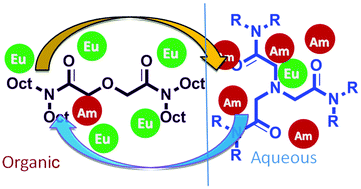Synthesis and evaluation of novel water-soluble ligands for the complexation of metals during the partitioning of actinides†
Abstract
Different types of water-soluble ![[double bond, length as m-dash]](https://www.rsc.org/images/entities/char_e001.gif) S donating
S donating

* Corresponding authors
a
Laboratory of Molecular Nanofabrication, MESA+ Institute for Nanotechnology, University of Twente, P.O. Box 217, 7500 AE Enschede, The Netherlands
E-mail:
w.verboom@utwente.nl
b Forschungszentrum Juelich GmbH, Institute of Energy and Climate Research-Nuclear Waste Management (IEK-6), 52425 Juelich, Germany
Different types of water-soluble ![[double bond, length as m-dash]](https://www.rsc.org/images/entities/char_e001.gif) S donating
S donating

 Please wait while we load your content...
Something went wrong. Try again?
Please wait while we load your content...
Something went wrong. Try again?
M. Iqbal, J. Huskens, M. Sypula, G. Modolo and W. Verboom, New J. Chem., 2011, 35, 2591 DOI: 10.1039/C1NJ20523D
To request permission to reproduce material from this article, please go to the Copyright Clearance Center request page.
If you are an author contributing to an RSC publication, you do not need to request permission provided correct acknowledgement is given.
If you are the author of this article, you do not need to request permission to reproduce figures and diagrams provided correct acknowledgement is given. If you want to reproduce the whole article in a third-party publication (excluding your thesis/dissertation for which permission is not required) please go to the Copyright Clearance Center request page.
Read more about how to correctly acknowledge RSC content.
 Fetching data from CrossRef.
Fetching data from CrossRef.
This may take some time to load.
Loading related content
